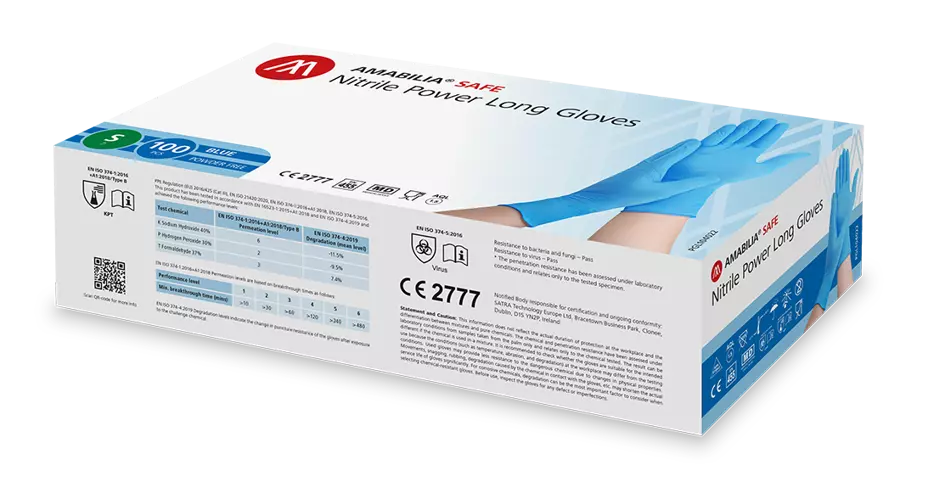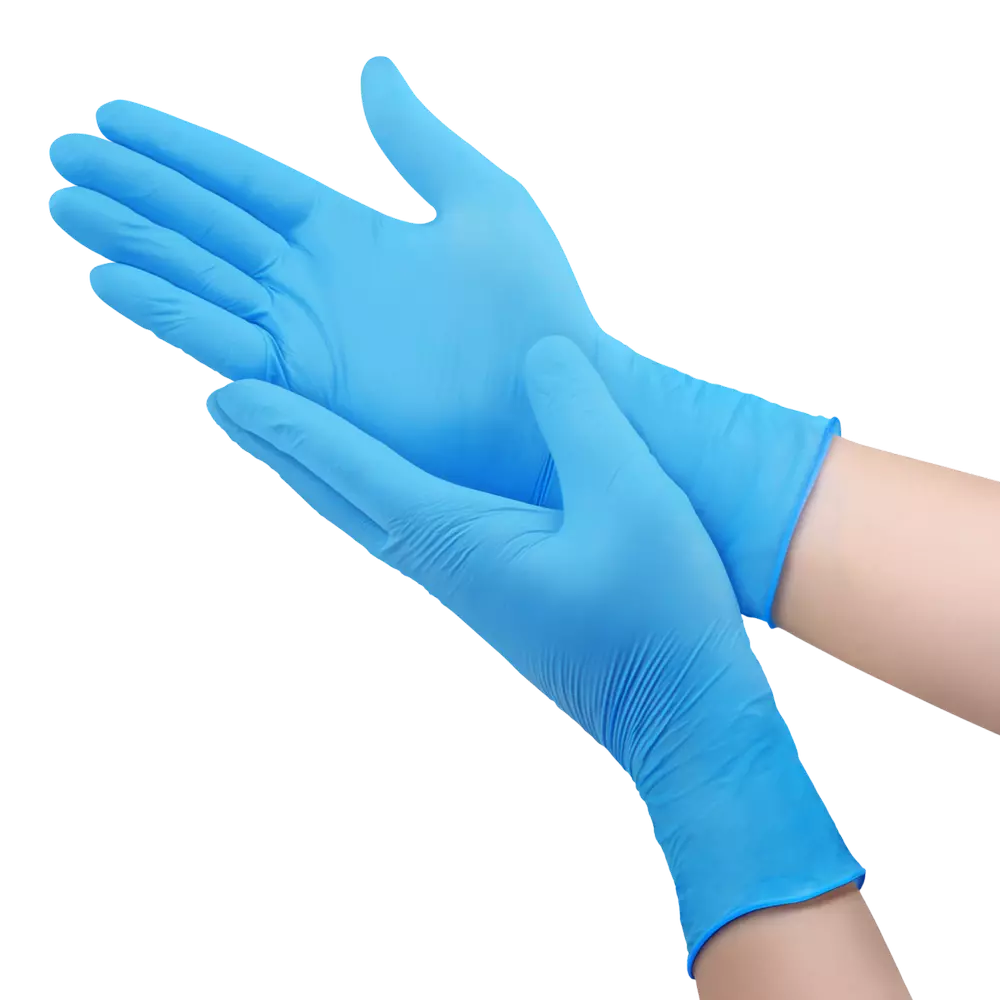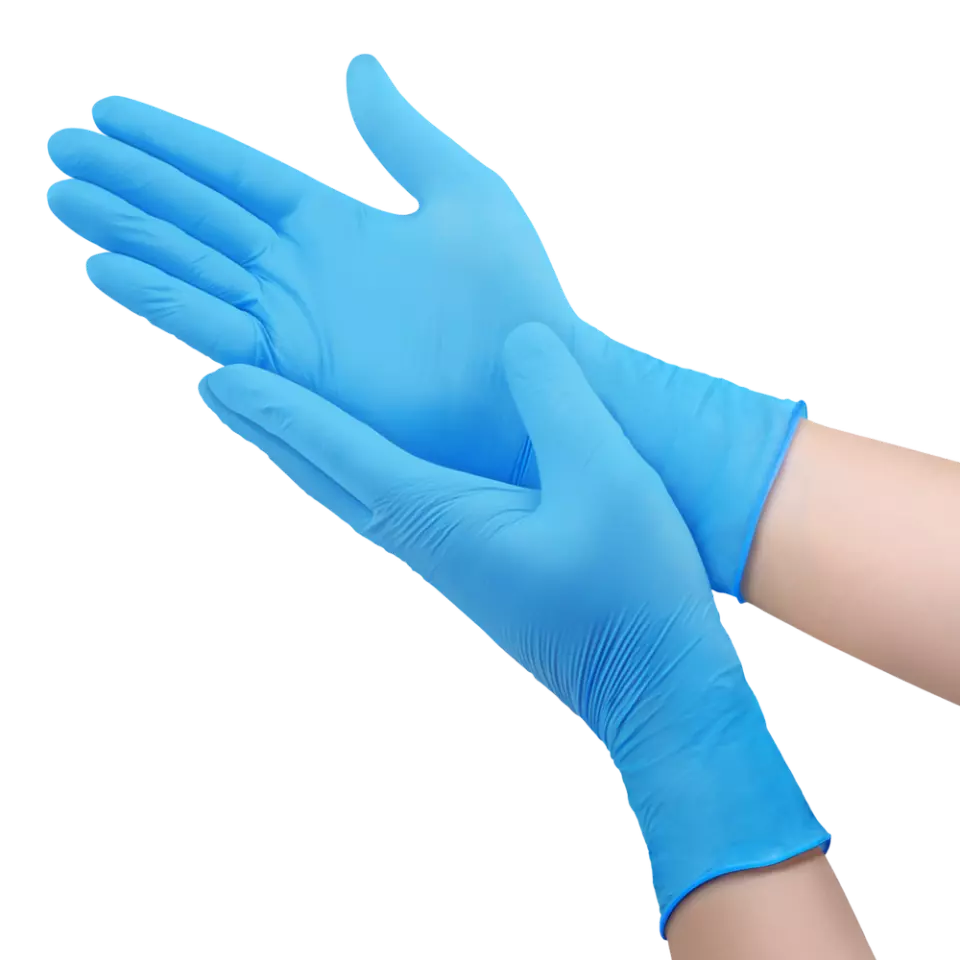
Amabilia Safe Nitrile Power Long Glove Blue
Amabilia Safe Nitrile Power Long Glove Blue
5 / 5




Features You'll Love

Cuff Style · Rolled
The design of the wrist opening, affecting ease of putting gloves on, comfort, and how securely they stay in place during use.
The design of the wrist opening, affecting ease of putting gloves on, comfort, and how securely they stay in place during use.
The design of the wrist opening, affecting ease of putting gloves on, comfort, and how securely they stay in place during use.
Amabilia
Safe Nitrile Power Long Glove Blue, 10 x 100 pcs
Safe Nitrile Power Long Glove Blue, 10 x 100 pcs
5 / 5
66,01 €
Price per 10 packages (1 000 pcs)
6,60 € / 100 pcs
Free delivery
Features You'll Love

Cuff Style · Rolled
The design of the wrist opening, affecting ease of putting gloves on, comfort, and how securely they stay in place during use.
The design of the wrist opening, affecting ease of putting gloves on, comfort, and how securely they stay in place during use.
The design of the wrist opening, affecting ease of putting gloves on, comfort, and how securely they stay in place during use.
Product description
Extended cuff for extra safety and protection
Length: 12 inches (approximately 30 cm)
Thickness: Fingers/palm 0.15/0.10 mm
Extended cuff for extra safety and protection
Length: 12 inches (approximately 30 cm)
Thickness: Fingers/palm 0.15/0.10 mm
Extended cuff for extra safety and protection
Length: 12 inches (approximately 30 cm)
Thickness: Fingers/palm 0.15/0.10 mm
Describes the surface texture of the fingertip area, affecting grip strength and tactile sensitivity during use.
Indicates the maximum percentage of defective gloves acceptable in quality testing, with lower numbers representing higher quality standards.
Indicates how long gloves maintain their protective properties and quality when stored properly, typically measured in years from manufacture date.
The design of the wrist opening, affecting ease of putting gloves on, comfort, and how securely they stay in place during use.
Measures the material thickness at the palm area, affecting protection level and tactile sensitivity during use.
Provides comfort and peace of mind, free from natural rubber latex to protect sensitive skin.
Long sleeves offer extended protection, keeping your arms clean and dry from splashes and contaminants, even during immersion.
Complete finger coverage ensures full protection and hygiene for your hands, maintaining dexterity for all tasks.
Your go-to gloves for diverse tasks, offering reliable protection and convenience across many applications.
Protects sensitive surfaces from silicone contamination, ensuring product integrity and quality.
Phthalate-free for reduced chemical exposure, offering a safer choice for you and the items you handle.
The base substance used to manufacture the glove, affecting chemical resistance, durability, flexibility, and compatibility with specific applications.
Total mass of the glove package, useful for shipping calculations, storage planning, and comparing product quantities across different brands.
Indicates whether gloves contain powder on the interior surface to aid donning, affecting ease of use and contamination control requirements.
The texture of the glove exterior, affecting grip strength and handling capability for different tasks and working conditions.
The visual appearance of the glove material, ranging from basic colors to specialized options for different professional and aesthetic preferences.
Measures the thickness of the glove's wrist/forearm extension, affecting durability, tear resistance, and protection level during use.
Measures the material thickness at the fingertips, affecting tactile sensitivity, dexterity, and protection level during use.
Measures how far the glove extends up the wrist and forearm, determining the level of coverage and protection provided during use.
- Chemical Resistance
- Antimicrobial Protection
- Hand Protection
Single-use medical gloves with the EN 455-3 rating are tested for biological safety, including potential chemical residues, latex proteins, and powder content. This ensures the gloves are safe for skin contact, minimizing the risk of irritation or allergic reactions for users and patients.
Medical gloves with the EN 455-2 rating are tested for physical properties like dimensions and strength, including force at break both before and after aging. This ensures the gloves fit correctly, are durable, and provide reliable protection against cross-contamination for both patient and user.
Medical gloves with the EN 455-1 rating are tested for freedom from holes to ensure they act as an effective barrier. This means the gloves reliably protect users and others from the transmission of microorganisms and contamination.
Medical gloves with the EN 455-4 rating are tested for their shelf life, ensuring they maintain critical properties like strength and barrier integrity over time. This means you can trust that the gloves will remain effective and safe to use until their expiration date, providing reliable protection when needed.
Medical devices with the ISO 13485:2016 rating are tested for a quality management system that ensures consistent safety, quality, and regulatory compliance throughout their lifecycle. This provides assurance that the product is reliably produced to high international standards for patient use.
Test results
This product was made under a quality management system that ensures consistent design, production, and distribution. This focuses on the safety, performance, and regulatory compliance of medical devices throughout their entire lifecycle, from design to disposal.
Products from companies with the ISO 14001:2015 rating are from organizations whose environmental management systems are verified for controlling their environmental impact, waste, and resource use. This means your purchase supports a company committed to sustainable operations and reducing its environmental footprint.
Test results
This product comes from a manufacturer that has an internationally recognized environmental management system. This system helps the company reduce its environmental impact by improving resource efficiency, reducing waste, and managing environmental risks.
Medical devices with the ISO 15223-1 rating are tested for clear and consistent communication of important information using standardized symbols. This means you can easily understand crucial safety and usage details on your medical products, regardless of language.
Medical devices, including software and diagnostic tools, with the EN ISO 14971:2019 rating are tested for how well their potential risks are identified, evaluated, and controlled throughout their entire lifespan. This rigorous process helps ensure the product is as safe as possible for you to use, with its benefits clearly outweighing any remaining small risks.
Products with the EN ISO 9001:2015 rating are tested for consistent quality management processes to meet customer and regulatory requirements. This means you can expect reliable products and services, as the company is committed to improving customer satisfaction.
Test results
This product is backed by a quality management system that ensures you receive consistent and dependable service. It focuses on providing reliable support and a positive customer experience, from initial contact to post-delivery activities.
Medical devices and their accessories with the EN ISO 20417:2021 rating are tested for clear and complete information supplied by the manufacturer, covering identification, labeling, packaging, and instructions. This ensures you receive essential details to use the product safely and effectively, promoting patient safety and confidence.
Gloves with the EN 374-4 rating are tested for resistance to degradation, which is how the glove material changes after chemical contact. This ensures the gloves maintain their protective strength and barrier, keeping your hands safe from hazardous chemicals.
Protective gloves with the EN ISO 21420:2020 rating are tested for general requirements, including design, construction, the absence of harmful chemicals, correct sizing, and dexterity. This ensures the gloves are safe and comfortable to wear, fit correctly, and won't cause adverse skin reactions.
Test results
Ensures gloves are designed for comfort, fit, and dexterity without using harmful materials. It covers general requirements like safe pH levels and non-toxic dyes, forming the foundation for all protective gloves.
Protective gloves with the EN 374-1 rating are tested for their ability to resist dangerous chemicals and micro-organisms, including how well they prevent leaks, chemical breakthrough, and material degradation. This rating helps you select gloves that provide certified protection for your hands when working with hazardous substances.
Gloves with the EN 374-5 rating are tested for protection against microorganisms like bacteria, fungi, and viruses. This ensures the gloves act as a reliable barrier, helping to keep you safe from harmful germs and reduce the risk of infection.
Gloves with the EN 374-2 rating are tested for resistance to penetration by liquids and microorganisms. This means the glove material is checked for physical defects like pinholes or leaks, ensuring it forms a barrier against harmful substances. You can trust these gloves to be waterproof and block microorganisms.
Protective clothing, gloves, and footwear materials with the EN 16523-1:2015+A1:2018 rating are tested for resistance to permeation by hazardous liquid chemicals. This means the material provides a measured level of protection against chemicals passing through it, helping you choose safety gear that resists liquid chemical exposure.
Test results
This product’s material is tested for resistance against breakthrough from potentially hazardous liquid chemicals. It measures the time it takes for a chemical to move through the material, ensuring protection during continuous contact.
REACH stands for "Registration, Evaluation, Authorisation and Restriction of Chemicals" it is a regulation of the European Union that governs the registration, evaluation, authorization, and restriction of chemicals. The REACH regulation aims to ensure that the chemicals used in Europe are safe for human health and the environment. The regulation applies to all chemical substances, whether they are used in industrial processes or in everyday products such as cleaning products, paints, and cosmetics. Companies that manufacture, import or use chemicals in the EU must register the chemicals they produce or import, provide safety information and communicate the risks associated with the chemicals. This information will be used to assess the risks and determine if any further action is needed to protect human health and the environment.
Food safe refers to the safety of food products that are used or consumed by people. In Europe, food safety is regulated by the European Union (EU) and the European Food Safety Authority (EFSA). These organizations set standards and requirements for food products to ensure they are safe to eat. To be considered "food safe" in Europe, a product must meet these standards and be free of harmful substances. This includes being free of harmful bacteria, pesticides, and other contaminants. Food products that do not meet these standards cannot be sold or used in the EU.
MD stands for "Medical Device." It refers to any instruments, apparatus, machines, implants, or other similar or related articles that are intended to be used for human beings for the purpose of diagnosis, prevention, monitoring, treatment or alleviation of disease, injury or disability. In Europe, a MD Label is a special label that must be on all Medical Devices that are sold or used in the European Union (EU). The label must include information about the product, such as the name of the manufacturer, the intended use of the product and CE mark. To be able to sell or use a Medical Device in the EU, the device must meet certain standards and requirements set by the European Union and notified body.
PPE stands for "personal protective equipment." PPE Category 3 refers to equipment that is complex and provide the highest level of protection such as powered respirators, SCBA, and full body suits. In Europe, PPE Category 3 must meet certain safety standards set by the European Union, which means that it must be designed and manufactured to protect the user without causing harm. Companies that make or sell PPE must prove that it meets these standards. They also must have a quality management system in place, have to be audited regularly by a notified body and have to have a technical documentation.
Free delivery for all Amabilia Medical products
Other products you may like
Similar products you may like
Find +150,000 products from hundreds of brands